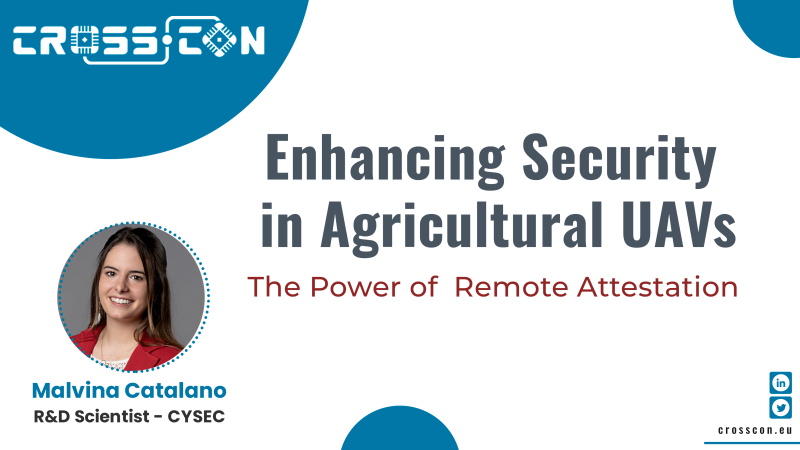
Author: Malvina Catalano, CYSEC
In today's modern agricultural landscape, Unmanned Aerial Vehicles (UAVs), commonly known as agricultural drones, are revolutionizing the way farmers operate. Equipped with advanced sensors and cameras, these UAVs provide invaluable data on crops and soil, enabling farmers to make informed decisions regarding planting, fertilization, irrigation, and pest control. While agricultural UAVs offer numerous benefits, they also pose security challenges that need to be addressed. In this blog post, we will explore the role of Remote Attestation (RA) in enhancing the security of agricultural UAVs and mitigating potential cybersecurity threats.

The Importance of Agricultural UAVs
Agricultural UAVs have become indispensable tools for farmers due to their various advantages. They improve efficiency by covering large areas quickly and accurately, reducing both time and costs compared to traditional methods. Precision agriculture is another key benefit, as UAVs provide high-resolution data on soil moisture, nutrient levels, and plant health, enabling precise application of resources and increasing yields while minimizing waste. These drones also help reduce the environmental impact by optimizing the use of pesticides and fertilizers, leading to sustainable farming practices. Furthermore, agricultural UAVs enhance safety by monitoring crops and livestock without exposing farmers to potential risks.
Security Challenges and Remote Attestation
Despite their numerous advantages, agricultural UAVs face security-related challenges that must be addressed. These challenges include privacy concerns, unauthorized access, and compliance with legal and regulatory requirements. To tackle these issues, RA emerges as a powerful solution, which involves the use of a trusted party, known as the Verifier, to remotely verify the status and integrity of the UAVs. This process ensures that only authorized and uncompromised devices are allowed to operate.
Let's now explore how RA can be applied to UAVs in different scenarios, ensuring their integrity and security:
RA plays a vital role in fleet identification and authentication. Before takeoff, the UAV requests a positive attestation report from the Verifier, confirming its authorized operational state. The Verifier checks the provided ID against its known IDs and challenges the UAV to generate a remote attestation report based on its current system status. If the measurements within the report are deemed acceptable according to the Verifier's appraisal policy, it approves the attestation, allowing the UAV to launch. Otherwise, the Verifier refuses the attestation, preventing unauthorized takeoff.
RA also ensures the in-flight software integrity of UAVs. When predefined suspicious events occur, such as deviations from regulated airspace or a lapse in time since the last attestation, an additional verification request is issued. The Verifier responds with either a positive or negative attestation, determining whether the UAV can continue operations. If the attestation is positive, operations resume, and the UAV resets the timer for recurrent attestation. In case of a negative attestation, the UAV can be configured to automatically initiate appropriate actions to stop operations safely.
One of the challenges faced by UAVs is their mobility and the potential lack of a reliable communication channel to a remote attestation server in certain environments. To address this, alternative methods such as asynchronous or offline attestation services can be employed to ensure similar levels of security in these edge cases.
Asynchronous attestation relies on swarm-authentication, where a collective decision is made by a majority of devices regarding the acceptance of attestation for an individual device. While offline attestation utilizes an internal attestation verifier residing within a highly secure enclave, inaccessible by the UAV's software itself, inside the device.
Conclusion
As agricultural UAVs continue to play a crucial role in modern farming practices, ensuring their security is of utmost importance. These UAVs face various cybersecurity threats, such as malware injection, data interception, unauthorized access, denial-of-service attacks, GPS jamming, and physical attacks. While RA cannot entirely eliminate these threats, it serves as an effective mechanism for their early detection. By verifying the trustworthiness of UAVs through secure boot mechanisms, code and data integrity checks, and encrypted communication channels, RA plays a fundamental role in mitigating these risks.
Embracing RA technology enables farmers to harness the full potential of agricultural UAVs while maintaining privacy, complying with regulations, and safeguarding against cyber threats.